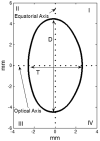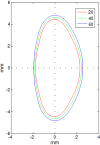Age-dependent Fourier model of the shape of the isolated ex vivo human crystalline lens
- PMID: 20338192
- PMCID: PMC2872038
- DOI: 10.1016/j.visres.2010.03.012
Age-dependent Fourier model of the shape of the isolated ex vivo human crystalline lens
Abstract
Purpose: To develop an age-dependent mathematical model of the zero-order shape of the isolated ex vivo human crystalline lens, using one mathematical function, that can be subsequently used to facilitate the development of other models for specific purposes such as optical modeling and analytical and numerical modeling of the lens.
Methods: Profiles of whole isolated human lenses (n=30) aged 20-69, were measured from shadow-photogrammetric images. The profiles were fit to a 10th-order Fourier series consisting of cosine functions in polar-co-ordinate system that included terms for tilt and decentration. The profiles were corrected using these terms and processed in two ways. In the first, each lens was fit to a 10th-order Fourier series to obtain thickness and diameter, while in the second, all lenses were simultaneously fit to a Fourier series equation that explicitly include linear terms for age to develop an age-dependent mathematical model for the whole lens shape.
Results: Thickness and diameter obtained from Fourier series fits exhibited high correlation with manual measurements made from shadow-photogrammetric images. The root-mean-squared-error of the age-dependent fit was 205 microm. The age-dependent equations provide a reliable lens model for ages 20-60 years.
Conclusion: The contour of the whole human crystalline lens can be modeled with a Fourier series. Shape obtained from the age-dependent model described in this paper can be used to facilitate the development of other models for specific purposes such as optical modeling and analytical and numerical modeling of the lens.
Copyright (c) 2010 Elsevier Ltd. All rights reserved.
Figures
















References
-
- Augusteyn RC, Rosen AM, Borja D, Ziebarth NM, Parel JM. Biometry of primate lenses during immersion in preservation media. Molecular Vision. 2006;12:740–747. - PubMed
-
- Augusteyn RC. Growth of the lens: in vitro observations. Clinical and Experimental Optometry. 2008;91:226–239. - PubMed
-
- Chien CM, Huang T, Schachar RA. A mathematical expression for the human crystalline lens. Comprehensive Therapy. 2003;29:245–258. - PubMed
Publication types
MeSH terms
Grants and funding
LinkOut - more resources
Full Text Sources
Other Literature Sources
Medical

